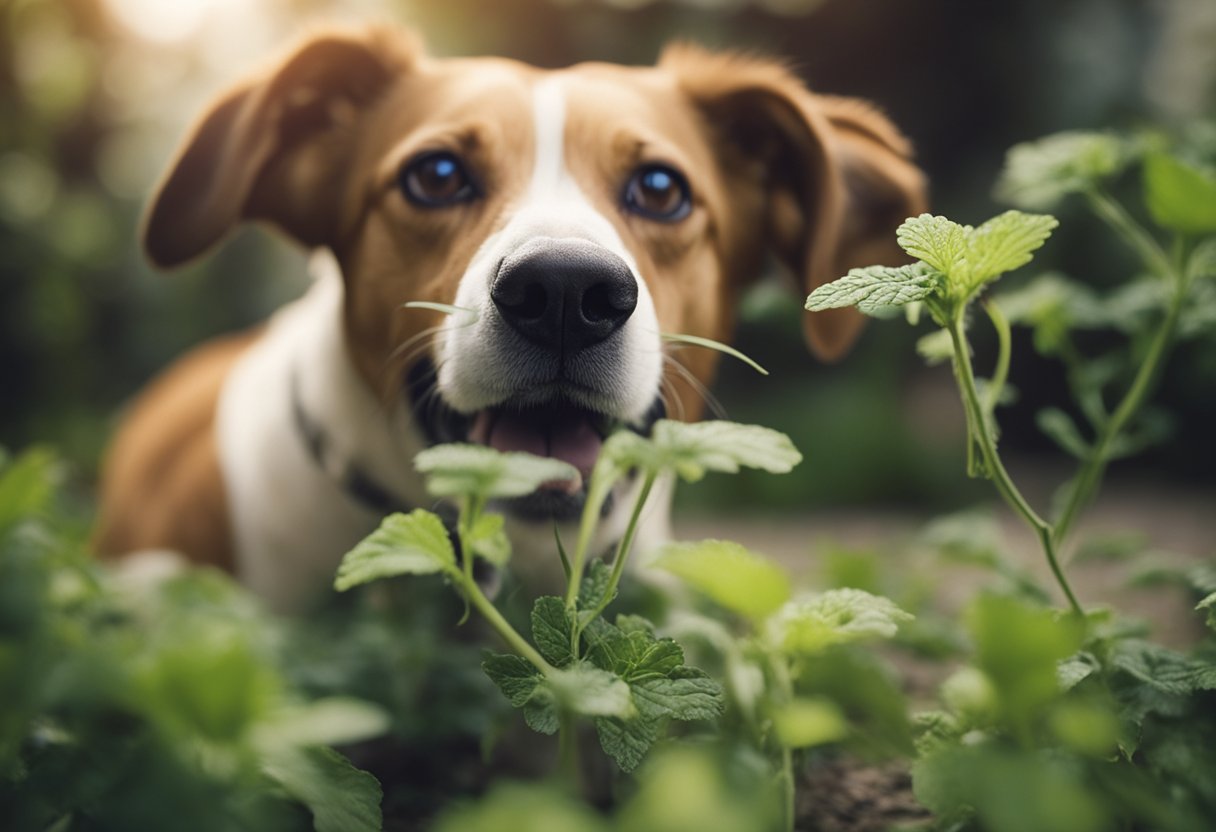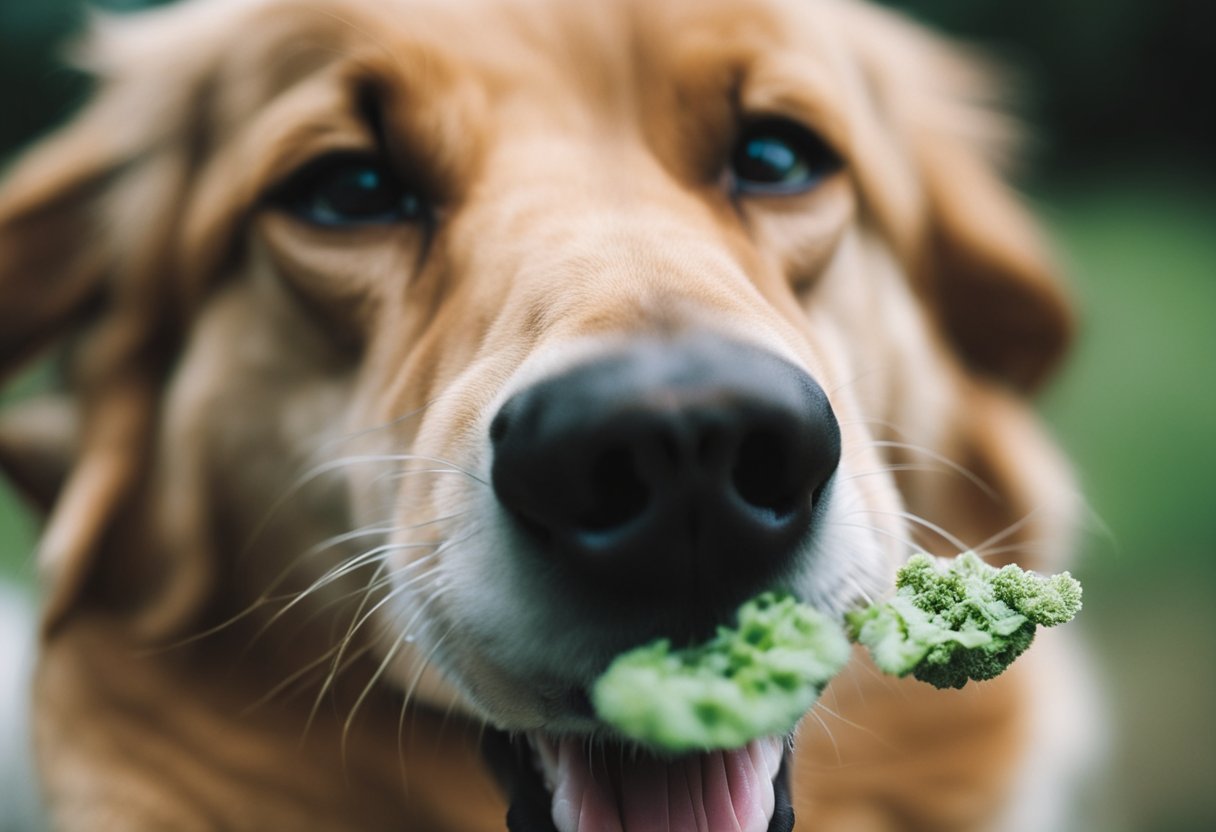Catnip, a herb belonging to the mint family, is famously known to elicit euphoric reactions in cats, but what about its effects on dogs? This member of the Nepeta species contains a compound called nepetalactone, which is the primary catalyst for the typical behaviors exhibited by felines when exposed to catnip. While it’s clear that catnip has a significant impact on cats, dog owners often wonder if it has a similar influence on their canine companions.

When considering catnip for dogs, it’s important to understand that they react to this herb differently than cats do. The calming and playful effects catnip has on cats don’t translate exactly the same way in dogs. However, research has shown that catnip can be safe for dogs to interact with in various forms. Whether it’s sniffing, chewing, or topical exposure, there are ways to safely incorporate catnip into a dog’s routine, all while monitoring their health and behavior.
Key Takeaways
- Catnip belongs to the mint family and contains nepetalactone, affecting animals.
- Dogs react differently to catnip compared to cats, typically without euphoric effects.
- Introducing catnip to dogs can be safe, but should be done with observation.
Understanding Catnip and Its Effects

Catnip, scientifically known as Nepeta cataria, is renowned for its effects on cats, but its influence extends beyond felines, showing varying impacts on dogs as well. This section delves into the specifics, from the chemical makeup to its usage as both a calming agent and a herb in food.
Chemical Composition of Catnip
Nepeta cataria is rich in essential oils and compounds, including the notable nepetalactone. Nepetalactone, along with other constituents like tannins and flavonoids, contributes to catnip’s distinctive effects.
Catnip’s Influence on Felines
Catnip triggers a range of reactions in cats, from euphoria to relaxation. This is due to nepetalactone mimicking feline pheromones and affecting their vomeronasal organ. The reactions can vary greatly, sometimes even stimulating male lions, tigers, and leopards.
Effects of Catnip on Dogs
While notorious for its impact on felines, the effects of catnip on dogs are more subdued. Dogs lack the vomeronasal organ sensitivity to nepetalactone, thus they do not experience the ‘high’ that cats do.
The Calming Effects of Catnip
For both humans and animals, the essential oils in catnip have a potential calming effect. It is sometimes used as a sedative and can alleviate issues like anxiety, leading to a mellow state and relaxation which can help with stress levels.
Catnip as Food and Herb
Used either fresh or dried, catnip is a versatile herb that can be found in many gardens. As food, catnip offers a mild flavor along with its calming properties and may be included in certain digestive aids to help alleviate digestive upset.
Health Benefits Beyond Calming
Catnip has a multitude of health benefits. It’s a source of vitamins C and E and contains minerals which may contribute to wound healing and gastrointestinal health. Some studies suggest benefits for sleep and conditions like arthritis.
Catnip Safety and Considerations for Dogs

When incorporating catnip into a dog’s routine, it is crucial to understand its safety, observe for any adverse reactions, and consider proper dosing. This section covers the essentials on how catnip affects canines, ensuring pet owners make informed decisions.
Is Catnip Safe for Dogs?
Catnip is regarded as generally safe for dogs. Many veterinarians confirm that both fresh and dried versions of the plant do not harm canines and may actually offer a sedative effect that can help to lower stress levels in anxious pets.
Potential Risks and Side Effects
While catnip is safe, dogs may experience side effects like stomach upset, which could lead to vomiting or diarrhea if they consume too much. Since catnip acts as a diuretic, increased urination is another potential effect. Always monitor a dog’s reaction and contact a vet if adverse symptoms are observed.
Recommended Usage and Dosage
The dose of catnip appropriate for a dog can vary. Start with a small amount and monitor the dog’s response. There’s no standardized dosage, but experts often suggest using a pinch to a teaspoon depending on the dog’s size. For tailored advice, owners should consult their veterinarian.
Alternatives to Catnip for Dogs
For owners seeking alternatives to catnip that are more suited to dogs, options like anise—which mirrors the effects of catnip—or herbs like fennel and licorice could be an affordable option. These herbs have properties similar to Pimpinella anisum, the botanical name for anise, and are safe for canine enjoyment.
Human Involvement and Practices

Humans play a significant role in utilizing catnip for the benefit of their canine companions. From incorporating it into the dog’s environment to consulting with professionals regarding pet health, responsible practices are crucial.
Incorporating Catnip in a Dog’s Environment
Catnip can be used to create a stimulating and enjoyable habitat for dogs. It’s common to sprinkle catnip in a dog’s bedding or toys to promote relaxation and playfulness. Dog owners might also plant catnip in their garden, which serves a dual purpose as a natural insect repellent while providing a readily available supply of the herb for their pets.
Natural Remedies and Preventive Measures
Catnip is known for its potential benefits as a natural remedy for certain digestive issues, such as gas, cramps, and diarrhea. It may also help in preventing vomiting. Some dog owners provide catnip to their pets to alleviate coughs or as a gentle sleep aid for those suffering from insomnia.
- Digestive Aid: Helps with gas, cramps, and diarrhea.
- Calmative: May reduce anxiety and aid dogs with insomnia.
The Role of Catnip in Pet Care
There’s a growing interest in using catnip for its calming effects on dogs with anxiety. When introduced responsibly, catnip may help dogs adapt to new situations with less stress. However, it’s important not to overdo it, as every dog may react differently to catnip.
- Relaxation: Offers potential relief for anxious or hyperactive dogs.
- Adaptogen: It may help dogs adjust to stressful conditions.
Consulting Professionals for Pet Health
Before giving catnip to dogs, it’s advisable to consult with a vet. Veterinarians can provide guidance on dosage and frequency to ensure that catnip is used safely as part of a dog’s care routine. They can also address potential allergies and ensure that catnip does not interfere with any existing conditions or medications.
Further Considerations and Final Thoughts

When considering the influence of catnip on pets, it’s essential to examine how it affects behavior, the variety of products available, dietary implications, and the long-term health impacts for both cats and dogs.
Behavioral Considerations for Cats and Dogs
Cats often exhibit an energetic response when exposed to catnip, engaging with cat toys and displaying heightened playfulness. Conversely, dogs may become mellow or appear slightly anxious due to the herb’s calming properties. Owners should observe their pets closely to understand how catnip uniquely affects their behavior.
Commercial Availability and Product Selection
When selecting catnip products, affordability is key. Consumers are advised to seek out affordable, high-quality options. It’s crucial to ensure that any product chosen is safe for pet consumption and free of harmful additives or contaminants.
Understanding the Boundaries of Pet Diet
Catnip should be considered a treat rather than a staple in a pet’s diet to prevent digestive issues. Responsible owners recognize that both food and supplements must be introduced carefully to maintain a balanced diet.
The Long-Term Impact of Catnip on Pets
While many pet owners have reported health benefits from catnip use, such as its calming effects, its long-term impact is not yet fully understood. Pets may enjoy the benefits of catnip when used appropriately, but as with any supplement, moderation is crucial to prevent adverse effects.
Frequently Asked Questions
This section addresses common queries regarding the effects of catnip on dogs and related subjects, providing clear and concise information for dog owners.
Is catnip harmful to dogs if ingested?
Catnip is generally considered safe for dogs to ingest in small amounts. However, consuming large quantities may lead to digestive upset.
What is the recommended amount of catnip for dogs?
There is no established recommended amount of catnip for dogs, but moderation is key. Starting with a small pinch can help gauge a dog’s reaction before offering more.
Are catnip toys suitable for dogs of all sizes?
Catnip toys can be suitable for dogs of all sizes, but it’s important to ensure the toys are appropriate for a dog’s size and chewing habits to prevent choking hazards.
Does catnip have a calming effect on dogs?
While catnip is well-known for its stimulating effect on cats, it can have a calming effect on dogs, helping to alleviate stress and promote relaxation in some individuals.
What is ‘Dognip’ and is it safe for dogs?
‘Dognip’ refers to alternative plants or herbs, such as anise, that are safe for dogs and can create a similar, yet typically milder, reaction compared to catnip.
How does silvervine affect dogs compared to catnip?
Silvervine may affect dogs similarly to catnip, potentially having a calming or playful effect, though individual reactions vary, and it should be offered sparingly at first.

